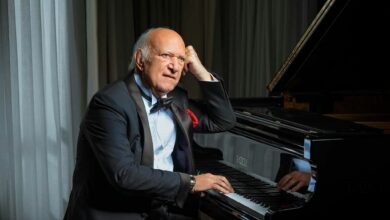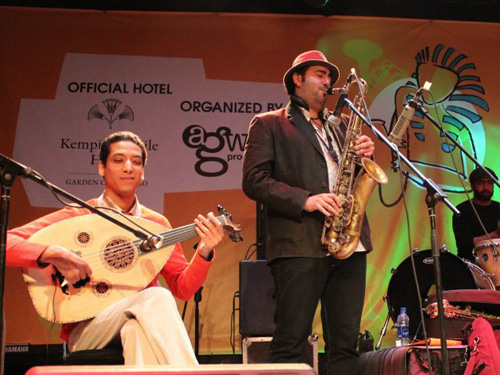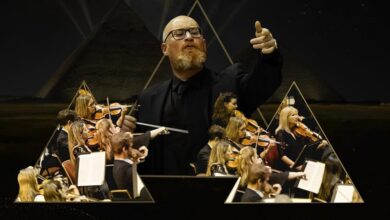Last Wednesday, ancient met modern at El Sawy Culture Wheel when the band Welad el-Faraana (Children of the Pharaohs), wearing jeans and t-shirts and playing pharaonic and Nubian instruments, resurrected the music of their Egyptian ancestors.
Welad al-Faraana signals a trend in contemporary Egyptian music, which has steadily begun welcoming pharaonic and Nubian music back into the scene. Currently, the National Project for Reviving Ancient Egyptian Music–headed by Khairi el-Malt, a music archeology researcher and the band leader–seeks to unearth ancient Egyptian music, revive its sound, and spread it all over the world via university courses and the manufacturing of instruments in the ancient Egyptian styles. That night at El Sawy Culture Wheel, a flier advertising a Diploma of Ancient Egyptian Music was being circulated through the audience.
“Modern and ancient Egyptian society is not only discernible through daily life and general behavior; it can be detected in instrumental and vocal music, as well as dance,” said el-Malt, the spotlight highlighting his excited smile. “Among the most important features of pharaonic culture is the role that music, song, and dance played to induce religious feeling inside temples,” he explained. “Because religion is fundamental to ancient Egyptian culture, music’s association with religion grants it a certain sacred quality.”
“But music also existed outside the temple, in the fields and between lovers,” el-Malt continued. By dissecting old pharaonic songs, he unearthed ideas very similar to those that appear in modern Egyptian music. This discovery made him feel connected to the past, as a musician and as an Egyptian. “We are a natural extension of the ancient civilization," he said.
Likewise, Nubian heritage is a vital element of Egyptian society. Nubia refers to the area in the south of Egypt along the Nile and in northern Sudan. When the Aswan Dam was constructed in the 1960s, over 100,000 Nubians became displaced. Some moved north into Egypt, and others south into Sudan.
Nubian sounds are kept alive today by artists like the Salamat band, Sayyed Gayer, Ahmed Moneib, and Mohammed Hammam. Hamza ad-Din, a Nubian composer famous for semi-classical oud (lute) compositions, and Ali Hassan Kuban are beloved worldwide.
On that summer night at El Sawy Culture Wheel, many melodies–tunes rising and falling as softly as calm breathing–transported listeners to ancient Egypt. The instruments, in earth colors and primitive designs, looked better-suited for a museum than the El Sakia stage, which normally hosts electric guitars and hip-hop. But the two worlds were connected that night. The pear lute, sleek wood with threads of fabric artfully dangling down from its side, showed itself to be the ancestor of the electric guitar, and the deep, rhythmic echoes reverberating from the Nubian doffs (drums) were reminiscent of modern hip-hop beats.
One pharaonic song in particular, called “Reincarnation,” seemed timelessly Egyptian. It skillfully and poignantly reflected life’s melancholy, the twinge of death, and the gift of rebirth. The sound, varied and unpredictable as waves on a stormy day, was a departure from the repetitious nature of the previous songs.
The pear lute, the ancient Egyptian nay (very similar to the modern flute), and the harp evoked different feelings. The heartrending lute brought to mind the river Nile and the essence of life. The nay stirred feelings of loneliness, a yearning for a lover’s attention, and the love of your country. The harpist’s swiftly dancing fingers also inspired feelings of love, particularly from one audience member–a man old enough to be a pharaoh himself–who asked if the ancient Egyptians were all as beautiful as the “queen of the harp,” as el-Malt dubbed her.
Another pharaonic song called “Constructing the Pyramids” matched its steady rhythm to the choreographed steps that workers must have followed while building the massive structures. An instrument made of strands of turquoise beads called to mind the crackle of the desert sand.
Slightly less captivating were the hieroglyphic (formal ancient Egyptian writing system) songs. Unlike the previous soft, rhythmic music, they were bizarre–the language unrecognizable–and difficult to imagine listening to again.
Nubian songs were more upbeat and also more familiar, enthusiastically received by the audience. One of the songs, “El Shamandoora,” is very popular, performed by mainstream Nubian singers such as Mohammed Mounir. “Even though we hear this song a lot, the difference is that we will play it using its original instruments, those used 4,000 years ago,” explained el-Malt.
To the audience’s delight, four Nubian dancers in colorful dress–two men and two women–began gliding across the stage. One of the drummers moved to the lower part of stage, enthusiastically striking his drum while other members of the band happily clapped their hands in celebration of Egyptian music, past and present.




